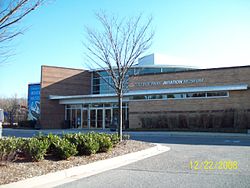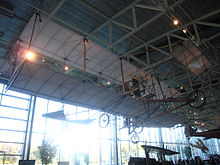- College Park Airport
-
College Park Airport IATA: CGS – ICAO: KCGS Summary Airport type Public Operator Maryland-National Capital Park & Planning Commission Location College Park, Maryland Elevation AMSL 48 ft / 14.6 m Coordinates 38°58′50.1″N 76°55′20.3″W / 38.980583°N 76.922306°WCoordinates: 38°58′50.1″N 76°55′20.3″W / 38.980583°N 76.922306°W Runways Direction Length Surface ft m 15/33 2,607 795 Asphalt College Park AirportCollege Park Aviation Museum, December 2008Nearest city: College Park, Maryland Built: 1908 Architect: Unknown Architectural style: No Style Listed Governing body: Local NRHP Reference#: 77001522
[1]Added to NRHP: September 23, 1977 College Park Airport (IATA: CGS, ICAO: KCGS) is a public airport located in the City of College Park, in Prince Georges County, Maryland, USA. It is the world's oldest continuously operated airport.[2]
Contents
History
College Park Airport was established in August 1909 by the United States Army Signal Corps to serve as a training location for Wilbur Wright to instruct two military officers to fly in the government's first aeroplane. Leased on August 25, the first airplane, a Wright Type A biplane, was uncrated and assembled on October 7. Civilian aircraft began flying from College Park Airport as early as December 1911, making it the world's oldest continuously operated airport. In 1977, the airport was added to the National Register of Historic Places.[1]
College Park Airport is home to many "firsts" in aviation, and is particularly significant for the well-known aviators and aviation inventors who played a part in this field's long history. In 1909 Wilbur Wright taught Lieutenants Frederic Humphreys and Frank Lahm. Humphreys became the first military pilot to solo in a government aeroplane.
Civilian aviation began at College Park with Rex Smith, an inventor and patent attorney, who operated the Rex Smith Aeroplane Company. Paul Peck and Tony Jannus were associates of his.
In 1911, the nation's first military aviation school was opened at College Park, with newly trained pilots then-Lt. Henry H. Arnold and Lt. Thomas DeWitt Milling as Wright pilot instructors and Capt. Paul W. Beck as the Curtiss instructor. The military aviation school saw numerous aviation firsts.
In 1915 Cecil Peoli, one of the world's first professional aviators, died testing his 12 cylinder Rausenburger-powered biplane at College Park in preparation for New York and St. Louis cross country flights.[3]
In 1918, after a three-month trial with the War Department beginning May 15, the Post Office Department inaugurated the first Postal Airmail Service from College Park, serving Philadelphia and New York (Belmont Park). Flights from College Park continued until 1921. The compass rose and original airmail hangar remain at the modern airport as a witness to this history. The Airport Code "CGS" originally referred to the airport's purpose in the 1930s as an airmail station. CGS = "ColleGe Station".
In 1920, Emile and Henry Berliner (father and son) brought their theories of vertical flight to the field and in 1924 made the first controlled helicopter flight.
From 1927 until 1933, the Bureau of Standards developed and tested the first radio navigational aids for use in "blind" or bad weather flying. This was the forerunner of the modern Instrument Landing System used today by aircraft.
In 1937, the Engineering & Research Corporation (ERCO), based in nearby Riverdale, Maryland, used the airport to test fly the early model of the Ercoupe, an airplane designed to be spin-proof.
George Brinckerhoff took over management of the Airfield and ran it from 1927 until 1959, hosting numerous airshows and teaching hundreds of pilots to fly during his tenure.
The Maryland-National Capital Park and Planning Commission (M-NCPPC) purchased the Airport in 1973 and it was added to the National Register of Historic Places in 1977. Today it is run as both a historic site and operating airport whose history is depicted in the 27,000 sq ft (2,500 m2) College Park Aviation Museum.
Since the 9/11 attacks, and owing to the airport's proximity to the national capital, the operations of the airport have been severely restricted by the Transportation Security Administration in the interest of national security, but civilian pilots are still free to use the airport after going through a one-time background check procedure.
Facilities
Airport facilities
College Park Airport covers 70 acres (280,000 m2) and has one runway:
- Runway 15/33: 2,607 x 60 ft (795 x 18 m), Surface: Asphalt
College Park Aviation Museum
The College Park Aviation Museum houses antique and reproduction aircraft associated with the history of College Park Airport. Artifacts and hands-on activities highlight the aviators, aircraft builders and airplanes that operated at the airport. Aircraft on display are:
- 1910 Wright Model B (replica)
- 1911 Curtiss Model D (replica)
- 1912 Blériot XI (replica)
- 1916 Curtiss JN-4D "Jenny"
- 1924 Berliner Helicopter No. 5
- 1932 Monocoupe 110
- 1936 Taylor J-2
- 1939 Taylorcraft BL-65
- 1941 Boeing-Stearman Model 75
- 1946 Erco Ercoupe 415D
The museum offers changing exhibits, special events, lectures, workshops and programs for the public, schools and groups. There are also an extensive library and archives which hold materials relating to the airport's history, early aviation history, especially relating to Maryland, and general aeronautics. Opened in 1998, the museum is an affiliate of the Smithsonian Institution.[4]
References
- ^ a b "National Register Information System". National Register of Historic Places. National Park Service. 2008-04-15. http://nrhp.focus.nps.gov/natreg/docs/All_Data.html.
- ^ Grier, Peter (2009). "The College Park Century". AIR FORCE Magazine 92 (September): 86. http://www.airforce-magazine.com/MagazineArchive/Pages/2009/September%202009/0909century.aspx. Retrieved 18 Sep 2009.
- ^ Aerial age. 19 April 1915.
- ^ "College Park Aviation Museum - USAF.com". USAF.com. http://www.usaf.com/museums/college_park_aviation_museum.htm. Retrieved 15 Jul 2011.
External links
- College Park Airport Main Website
- M-NCPPC College Park Airport
- College Park Aviation Museum
- Aviation: From Sand Dunes to Sonic Booms, a National Park Service Discover Our Shared Heritage Travel Itinerary
- College Park Airport in the early 1930s (with photos)
- Resources for this airport:
- AirNav airport information for KCGS
- ASN accident history for CGS
- FlightAware airport information and live flight tracker
- NOAA/NWS latest weather observations
- SkyVector aeronautical chart, Terminal Procedures for KCGS
- College Park Airport, Prince George's County, Inventory No.: PG:66-4, including aerial photo in 1937, at Maryland Historical Trust website
- M-NCPPC Inventory of Historic Sites (Prince George's County); College Park Airport, entry 66-004, p. 38
U.S. National Register of Historic Places in Maryland Lists by county Allegany • Anne Arundel • Baltimore County • Calvert • Caroline • Carroll • Cecil • Charles • Dorchester • Frederick • Garrett • Harford • Howard • Kent • Montgomery • Prince George's • Queen Anne's • Somerset • St. Mary's • Talbot • Washington • Wicomico • Worcester

Lists by city Other lists Categories:- Airports in Maryland
- Buildings and structures on the National Register of Historic Places in Maryland
- Airports established in 1909
- Buildings and structures in Prince George's County, Maryland
- Transportation in Prince George's County, Maryland
- Aviation in Maryland
- Smithsonian Institution affiliates
Wikimedia Foundation. 2010.




